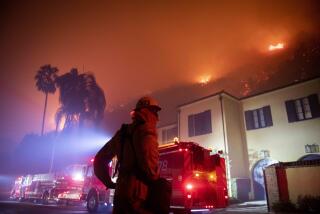Home Savings Seeks to Switch Deposit Insurers : Nation’s Biggest Thrift Prefers Fund for Banks Over Ailing Agency for S
- Share via
Home Savings of America, the country’s biggest thrift, said Friday that it is seeking approval to drop its membership in the Federal Savings & Loan Insurance Corp. and to join the deposit insurance system for commercial banks.
The Los Angeles-based financial institution indicated that the move was sparked by the Bush Administration’s plan to increase levies on thrifts to help fund hundreds of S&L; failures.
The move underscores the turmoil surrounding FSLIC, an insolvent government agency that gets its funds from the nation’s 3,000 federally insured savings and loans. FSLIC’s job is to rescue troubled thrifts and protect deposits up to $100,000 per account.
Home Savings has joined a growing group of healthy thrifts in California that are signaling they want to leave the FSLIC system and to receive coverage instead from the Federal Deposit Insurance Corp.
“This is their way of saying of saying: ‘We’re mad as hell and won’t take it any more,’ ” said Allan Bortel, a financial analyst for Shearson Lehman Hutton.
“We have been fed up for a long time,” agreed a spokeswoman for Home Savings.
Two other thrifts that want to drop their FSLIC insurance in favor of FDIC coverage are Great Western Financial in Beverly Hills and Home Federal Savings in San Diego.
The rescue plan proposed by Bush, estimated to cost anywhere from $126 billion to more than $300 billion, is to be financed largely by U.S. taxpayers and the thrift industry.
To come up with the money, annual thrift premiums will be temporarily increased from 21 cents to 23 cents on every $100 of deposits.
Thus, the larger the thrift, the larger the premium that it will have to pay. Home Savings has deposits of nearly $30 billion and more than 350 offices in nine states.
Its size means that the firm “will be forced to bear the largest cost burden to resolve the problems of the FSLIC--problems we did not create,” Home Savings Chief Executive Richard H. Deihl said in a statement.
FSLIC has traditionally insured deposits at savings and loans, while the FDIC insures deposits at commercial banks. Though thrifts have specialized in mortgage lending and banks in business loans, those differences have become increasingly blurred in recent years as banks and thrifts have begun making the same kinds of investments.
Unlike the FSLIC, the FDIC is solvent and charges its members far less for deposit insurance. Deihl said Home Savings paid nearly $50 million for deposit insurance in 1988--double what it would have paid if it were FDIC-insured.
One potential roadblock to Home Savings’ plan is that the Bush proposal, which must be approved by Congress, would bar shifts from FSLIC to FDIC for five years. The five-year ban would extend a moratorium mandated by Congress that is scheduled to expire in August.
Home Savings officials believe that they would qualify for a “grandfather” exemption to the extension because the firm indicated nearly two years ago--before the Congressional ban went into effect--that it might apply for FDIC insurance.
If regulators find the grandfather exemption to be valid, “then I assume they will be allowed to leave,” said Karl Hoyle, a spokesman for the Federal Home Loan Bank Board.
To effect the change, Home Savings has applied for permission to merge its operations into its wholly owned Bowery Savings Bank, which is based in New York and is already insured by the FDIC.
The move is similar to an application filed last October by Great Western Financial, which wants to merge its FSLIC-insured operations in California, Florida and Arizona into its FDIC-insured holdings in the state of Washington. A Great Western spokesman said the application is pending.
More to Read
Inside the business of entertainment
The Wide Shot brings you news, analysis and insights on everything from streaming wars to production — and what it all means for the future.
You may occasionally receive promotional content from the Los Angeles Times.










